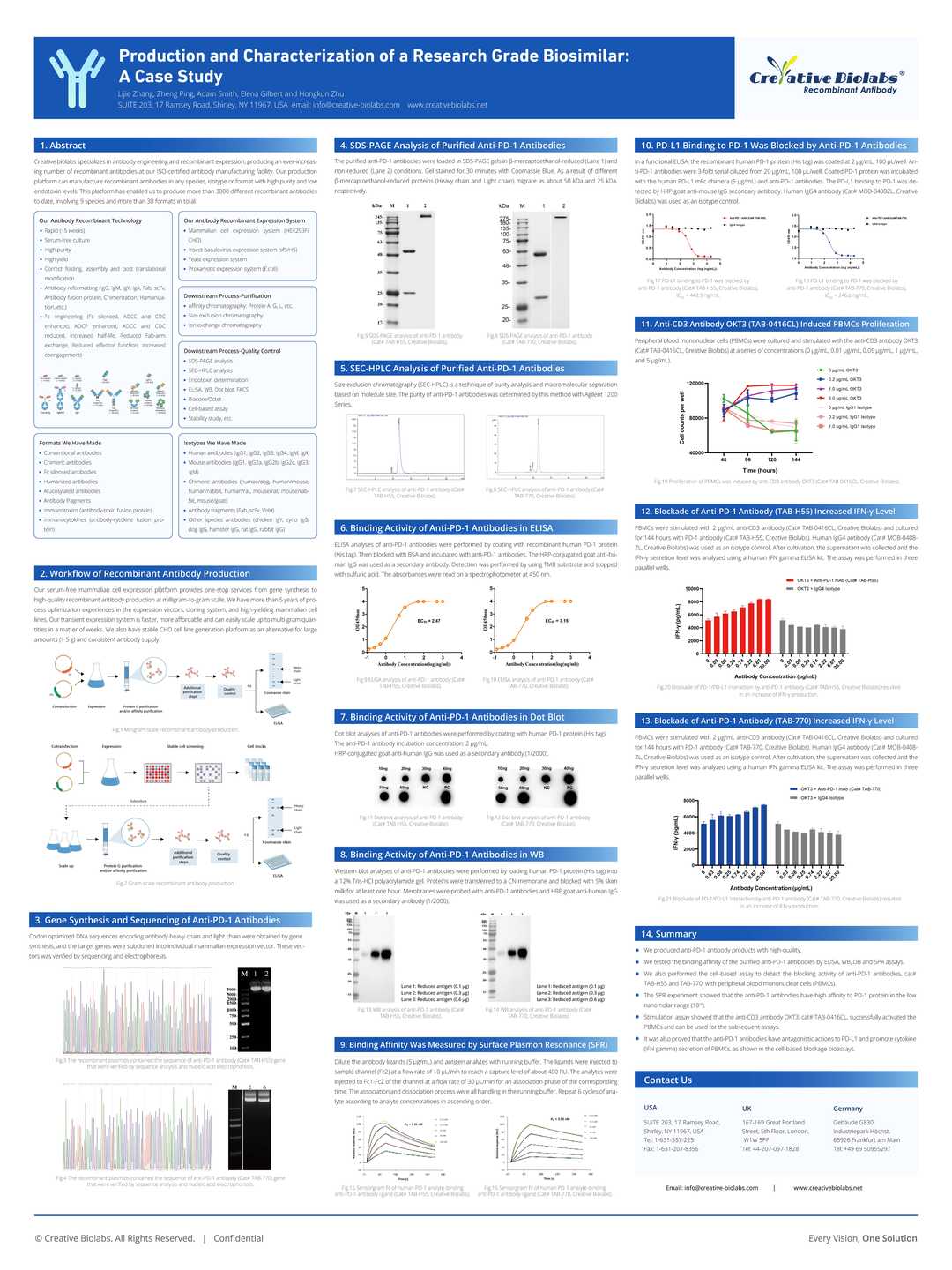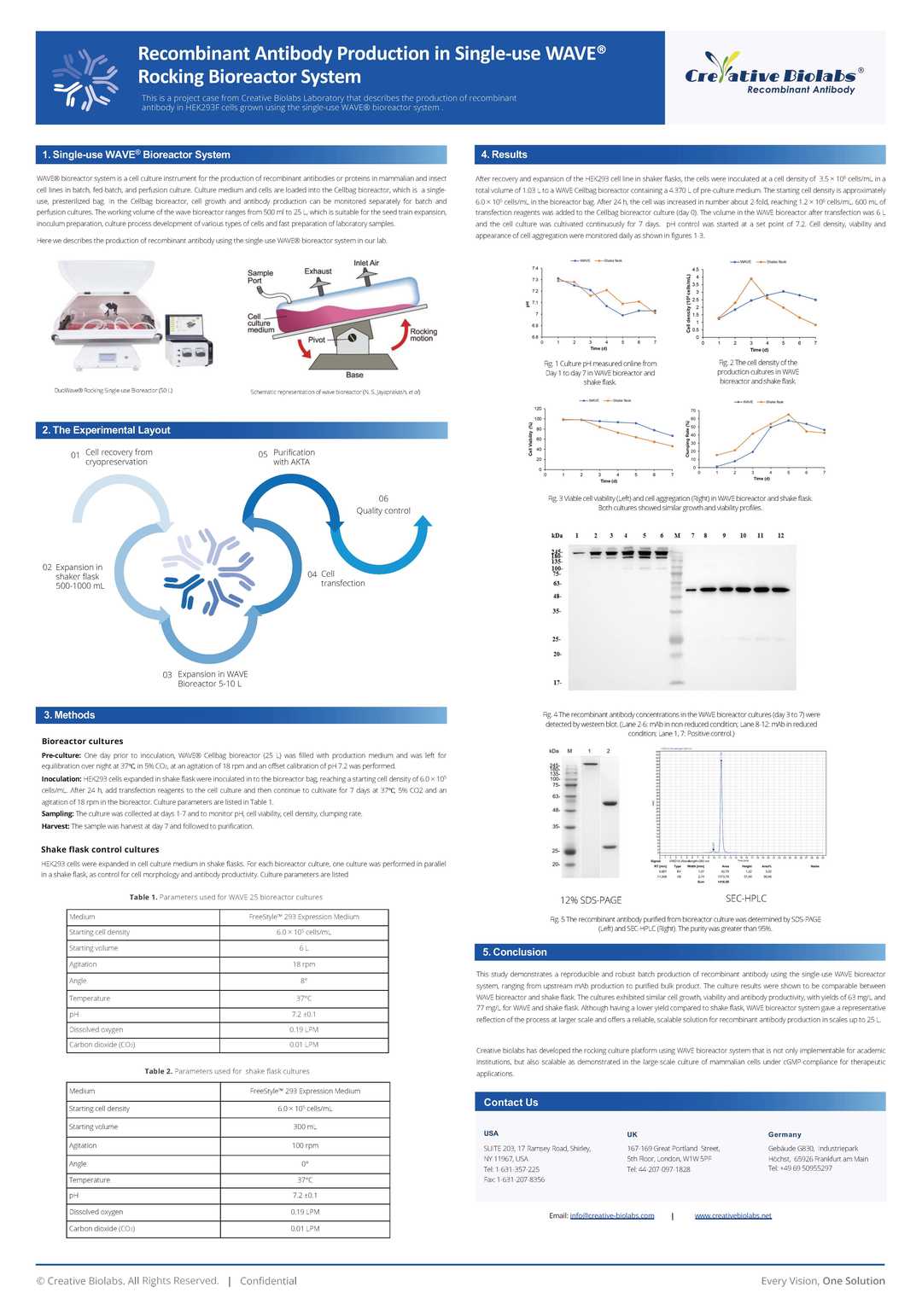Rabbit Anti-Hypusine Recombinant Antibody (PABL-202)
CAT#: PABL-202
Recombinant Rabbit Antibody is capable of binding to Hypusine, expressed in Chinese Hamster Ovary cells (CHO).

Specifications
- Immunogen
- Human Hypusine
- Host Species
- Rabbit
- Type
- Rabbit IgG
- Specificity
- Human Hypusine
- Species Reactivity
- Human
- Applications
- WB, ELISA, FuncS
Product Property
- Purity
- >95% as determined by SDS-PAGE and HPLC analysis
- Concentration
- Please refer to the vial label for the specific concentration.
- Storage
- Centrifuge briefly prior to opening vial. Store at +4°C short term (1-2 weeks). Aliquot and store at -20°C long term. Avoid repeated freeze/thaw cycles.
Applications
- Application Notes
- The antibody was validated for ELISA and WB. For details, refer to published data.
Target
- Alternative Names
- Hypusine
Customer Review
There are currently no Customer reviews or questions for PABL-202. Click the button above to contact us or submit your feedback about this product.
 Laura Hernandez
Laura Hernandez Brian Anderson
Brian Anderson Megan Thompson
Megan ThompsonQ&As
-
Is the anti-Hypusine recombinant antibody specific for eIF5A?
A: Yes, the anti-Hypusine recombinant antibody (PABL-202) is specific for eIF5A. It has been validated to detect hypusine-modified eIF5A, making it a reliable tool for studying the role of this protein in various biological processes.
-
What applications are suitable for using the anti-Hypusine recombinant antibody?
A: The anti-Hypusine recombinant antibody (PABL-202) is suitable for applications such as Western blotting, immunoprecipitation, and immunofluorescence. It provides specific detection of hypusine-modified eIF5A in these types of experiments.
-
Can the anti-Hypusine recombinant antibody be used for flow cytometry analysis?
A: Yes, the anti-Hypusine recombinant antibody (PABL-202) can be used for flow cytometry applications. It is specifically designed to bind to hypusine-modified eIF5A, making it suitable for such use.
-
What is the optimal dilution for using the anti-Hypusine recombinant antibody in immunofluorescence?
A: The optimal dilution for using the anti-Hypusine recombinant antibody (PABL-202) in immunofluorescence is typically 1:100 to 1:500. It is advisable to perform a dilution series to determine the best working concentration for specific experimental conditions.
-
Can the anti-Hypusine recombinant antibody be used in immunohistochemistry on formalin-fixed, paraffin-embedded (FFPE) tissue sections?
A: Yes, the anti-Hypusine recombinant antibody (PABL-202) can be used in immunohistochemistry on FFPE tissue sections. It provides specific staining of hypusine-modified eIF5A, allowing for detailed analysis of its expression in tissue samples.
View the frequently asked questions answered by Creative Biolabs Support.
Citations
-
Tan, Thomas CJ, et al. "Translation factor eIF5a is essential for IFNγ production and cell cycle regulation in primary CD8+ T lymphocytes." Nature Communications 13.1 (2022): 7796. https://doi.org/s41467-022-35252-yThis study investigates the essential role of the translation factor eIF5a in the production of interferon-gamma (IFNγ) and the regulation of the cell cycle in primary CD8+ T lymphocytes. The research demonstrates that eIF5a is dynamically regulated through post-translational modification in naïve CD8+ T cells upon activation, facilitating the translation of specific subsets of proteins crucial for long-term survival and effector functions. The study underscores the importance of eIF5a in the coordination of immune responses by controlling the translation of mRNAs that regulate proliferation and key effector functions, including the production of IFNγ.
At Creative Biolabs, we supplied the hypusine antibody Hpu24 (Cat#: PABL-202) used in flow cytometry and Western blotting analyses. Our products were crucial in enabling the detailed examination of eIF5a's role in T cell activation and function. This study's significance lies in its potential to uncover new therapeutic targets for enhancing immune responses and treating conditions related to immune dysfunction, highlighting our commitment to advancing immunological research and innovative solutions. -
Zhang, Hanlin, et al. "Polyamines control eIF5A hypusination, TFEB translation, and autophagy to reverse B cell senescence." Molecular cell 76.1 (2019): 110-125. https://doi.org/10.1016/j.molcel.2019.08.005This study reveals a significant pathway in immune aging, showing how the polyamine metabolite spermidine controls cellular autophagy through a mechanism involving eIF5A hypusination and TFEB translation. The researchers demonstrate that spermidine levels decline with age, leading to reduced eIF5A hypusination, decreased TFEB expression, and impaired autophagy in immune cells, particularly B cells. Remarkably, supplementing spermidine restored this pathway and improved B cell responses in both aged mice and humans, effectively rejuvenating immune function. The study identifies a novel translational control mechanism for autophagy regulation that can potentially be targeted to reverse immune senescence.
Creative Biolabs provided the hypusine-specific antibody (PABL-202) to detect and quantify hypusinated eIF5A in various cell types and experimental conditions. This antibody allowed for precise monitoring of the post-translational modification status of eIF5A, which was essential for establishing the mechanistic link between spermidine levels, eIF5A hypusination, TFEB expression, and autophagy activity. The ability to specifically track hypusinated eIF5A was fundamental to demonstrating how this pathway becomes dysregulated during aging and how it can be restored through spermidine supplementation.
Cite This Product
To accurately reference this product in your publication, please use the following citation information:
(Creative Biolabs Cat# PABL-202, RRID: AB_2877637)
Submit Your Publication
Published with our product? Submit your paper and receive a 10% discount on your next order! Share your research to earn exclusive rewards.
Publications
Peer-reviewed PublicationsOur products have been used extensively by scientists all over the world to accelerate their life science research. Here, we present a collection of publications that cite this product.
Downloadable Resources
Download resources about recombinant antibody development and antibody engineering to boost your research.
Product Notes
This is a product of Creative Biolabs' Hi-Affi™ recombinant antibody portfolio, which has several benefits including:
• Increased sensitivity
• Confirmed specificity
• High repeatability
• Excellent batch-to-batch consistency
• Sustainable supply
• Animal-free production
See more details about Hi-Affi™ recombinant antibody benefits.
Datasheet
MSDS
COA
Certificate of Analysis LookupTo download a Certificate of Analysis, please enter a lot number in the search box below. Note: Certificate of Analysis not available for kit components.
See other products for "Hypusine"
Select a product category from the dropdown menu below to view related products.
| CAT | Product Name | Application | Type |
|---|---|---|---|
| PSBL-202 | Rabbit Anti-Hypusine Recombinant Antibody scFv Fragment (PSBL-202) | WB, ELISA, FuncS | Rabbit scFv |
| PSBL-577 | Rabbit Anti-Hypusine Recombinant Antibody (clone Hpu98); scFv Fragment | WB, ELISA, FuncS | Rabbit scFv |
| HPAB-2335LY-S(P) | Rabbit Anti-Hypusine Recombinant Antibody; scFv Fragment (HPAB-2335LY-S(P)) | ELISA, FuncS | Rabbit scfv |
| HPAB-2336LY-S(P) | Rabbit Anti-Hypusine Recombinant Antibody; scFv Fragment (HPAB-2336LY-S(P)) | ELISA, FuncS | Rabbit scfv |
| HPAB-2337LY-S(P) | Rabbit Anti-Hypusine Recombinant Antibody; scFv Fragment (HPAB-2337LY-S(P)) | ELISA, FuncS | Rabbit scfv |
| CAT | Product Name | Application | Type |
|---|---|---|---|
| PFBL-202 | Rabbit Anti-Hypusine Recombinant Antibody Fab Fragment (PFBL-202) | WB, ELISA, FuncS | Rabbit Fab |
| PFBL-577 | Rabbit Anti-Hypusine Recombinant Antibody (clone Hpu98); Fab Fragment | WB, ELISA, FuncS | Rabbit Fab |
| HPAB-2335LY-F(E) | Rabbit Anti-Hypusine Recombinant Antibody; Fab Fragment (HPAB-2335LY-F(E)) | ELISA, FuncS | Rabbit Fab |
| HPAB-2336LY-F(E) | Rabbit Anti-Hypusine Recombinant Antibody; Fab Fragment (HPAB-2336LY-F(E)) | ELISA, FuncS | Rabbit Fab |
| HPAB-2337LY-F(E) | Rabbit Anti-Hypusine Recombinant Antibody; Fab Fragment (HPAB-2337LY-F(E)) | ELISA, FuncS | Rabbit Fab |
| CAT | Product Name | Application | Type |
|---|---|---|---|
| PABL-582 | Rabbit Anti-Hypusine Recombinant Antibody (PABL-582) | WB, ELISA, FuncS | Rabbit IgG |
| HPAB-2335LY | Rabbit Anti-Hypusine Recombinant Antibody (HPAB-2335LY) | ELISA, FuncS | Rabbit IgG |
| HPAB-2336LY | Rabbit Anti-Hypusine Recombinant Antibody (HPAB-2336LY) | ELISA, FuncS | Rabbit IgG |
| HPAB-2337LY | Rabbit Anti-Hypusine Recombinant Antibody (HPAB-2337LY) | ELISA, FuncS | Rabbit IgG |
Popular Products

Application: WB, FC, IP, ELISA, Neut, FuncS, IF

Application: ELISA, FC, IP, FuncS, IF, Neut, ICC

Application: ELISA, FC, IP, FuncS, IF, Neut, ICC

Application: Neut, ELISA, IF, IP, FuncS, FC, WB

Application: WB, ELISA, FuncS

Application: ELISA, FuncS, IHC, IF, FC, ADCC

Application: SPR, Inhib, FuncS

Application: WB, ELISA, IF, FuncS, Apop, BA

Application: ELISA, IHC, FC, IP, IF, FuncS

Application: ELISA, IHC, FC, IP, IF, FuncS

Application: ELISA, FuncS

Application: FC, IHC, Cyt, FuncS

Application: ELISA, Neut, FuncS
For research use only. Not intended for any clinical use. No products from Creative Biolabs may be resold, modified for resale or used to manufacture commercial products without prior written approval from Creative Biolabs.
This site is protected by reCAPTCHA and the Google Privacy Policy and Terms of Service apply.















